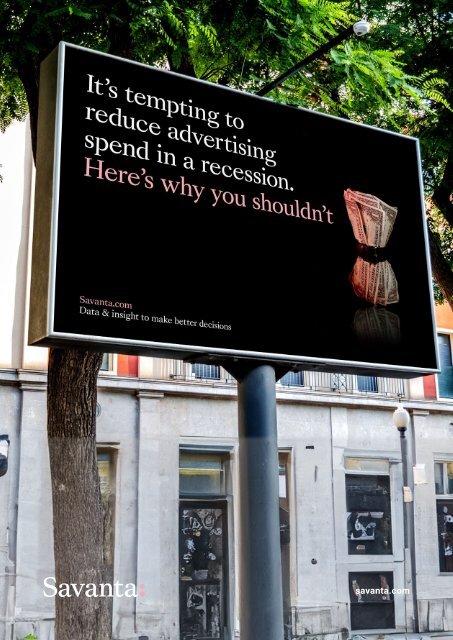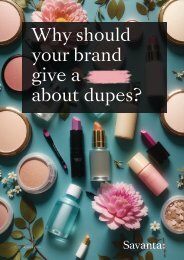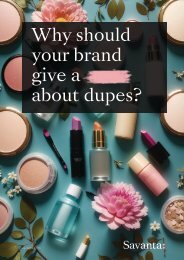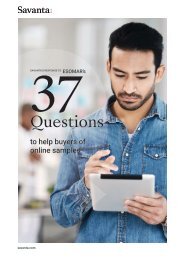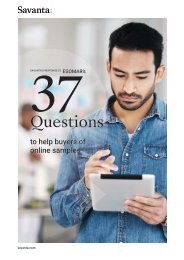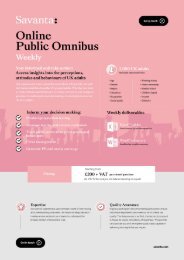Savanta: Advertising in a recession
During a recession it’s can be tempting to look at your advertising budget as a ‘nice to have’ rather than an essential. Our research shows that it’s absolutely imperative that brands maintain their advertising spends during a recession. To understand why, this report looks in more detail at the purpose of advertising, how recessions impact advertising spend, and the risks and opportunities for brands navigating these choppy waters.
During a recession it’s can be tempting to look at your advertising budget as a ‘nice to have’ rather than an essential. Our research shows that it’s absolutely imperative that brands maintain their advertising spends during a recession. To understand why, this report looks in more detail at the
purpose of advertising, how recessions impact advertising spend, and the risks and opportunities for brands navigating these choppy waters.
You also want an ePaper? Increase the reach of your titles
YUMPU automatically turns print PDFs into web optimized ePapers that Google loves.
savanta.com
It’s tempt<strong>in</strong>g to reduce advertis<strong>in</strong>g spend <strong>in</strong> a <strong>recession</strong>...<br />
...here’s why you shouldn’t<br />
WHAT IS THE PURPOSE OF<br />
ADVERTISING?<br />
INTRODUCTION<br />
In February, the UK entered a technical <strong>recession</strong>,<br />
with GDP figures show<strong>in</strong>g the economy contract<strong>in</strong>g<br />
by 0.3% <strong>in</strong> Q4 2023.. This will have major implications<br />
for policymakers, consumers and bus<strong>in</strong>esses.<br />
Those <strong>in</strong> market<strong>in</strong>g departments across the country<br />
will be look<strong>in</strong>g at severe economic headw<strong>in</strong>ds, and<br />
potentially be<strong>in</strong>g asked to further squeeze already<br />
tight budgets. It’s tempt<strong>in</strong>g at this time to look at<br />
your advertis<strong>in</strong>g budget as a ‘nice to have’ rather<br />
than an essential.<br />
However, our research shows that it’s absolutely<br />
imperative that brands ma<strong>in</strong>ta<strong>in</strong> their advertis<strong>in</strong>g<br />
spend dur<strong>in</strong>g a <strong>recession</strong>. The risk is, if you don’t,<br />
consumers will forget your brand and it will take<br />
a long time (and more budget) to become front of<br />
m<strong>in</strong>d once more.<br />
By advertis<strong>in</strong>g, we really mean any market<strong>in</strong>g<br />
communications which direct attention to a product,<br />
offer<strong>in</strong>g or service. Its core purpose is to <strong>in</strong>fluence<br />
the behaviour of a target audience, whether that is<br />
coax<strong>in</strong>g tangible, commercial actions, like mak<strong>in</strong>g a<br />
purchase, or more abstract and emotional responses,<br />
such as adopt<strong>in</strong>g a specific viewpo<strong>in</strong>t about a<br />
brand. The role of market<strong>in</strong>g communications is to<br />
establish, ma<strong>in</strong>ta<strong>in</strong>, and grow a relationship between<br />
the advertiser and consumers. That relationship is<br />
not unlike all other relationships <strong>in</strong> life: the more a<br />
personal relationship is <strong>in</strong>vested <strong>in</strong>, the stronger it<br />
becomes, be it with friends, family or your partner.<br />
Understand<strong>in</strong>g the dynamic between the audience<br />
and a brand is therefore equally crucial. Much like<br />
many of our personal relationships <strong>in</strong> life, the strength<br />
of the brand-consumer relationship is impacted by<br />
the time, effort, and attention <strong>in</strong>vested <strong>in</strong> it. It’s no<br />
co<strong>in</strong>cidence that <strong>in</strong>dividuals often cite a breakdown<br />
<strong>in</strong> communication as a reason for relationships<br />
weaken<strong>in</strong>g; the same holds true for market<strong>in</strong>g.<br />
This is particularly important over longer-time<br />
periods. In the 1989s Gordon Brown, co-founder<br />
of Millward Brown, expla<strong>in</strong>ed that long-term<br />
memory lets advertis<strong>in</strong>g exert <strong>in</strong>fluence over brand<br />
<strong>in</strong>teractions across an extended period. Brown<br />
claims a strong advertis<strong>in</strong>g execution will associate<br />
“relevant messages and images with the brand <strong>in</strong><br />
a memorable way so that they are carried forward<br />
through time to imbue the brand with <strong>in</strong>terest and<br />
status”.<br />
But more than this, there is an opportunity for brands<br />
to lean <strong>in</strong>. If you ma<strong>in</strong>ta<strong>in</strong> your advertis<strong>in</strong>g spend<br />
while many others don’t, there aren’t many easier (or<br />
cheaper) ways to <strong>in</strong>crease your share of voice <strong>in</strong> the<br />
market.<br />
HOW DO ECONOMIC RECESSIONS<br />
IMPACT ADVERTISING SPEND?<br />
To understand why, let’s look <strong>in</strong> more detail, at the<br />
purpose of advertis<strong>in</strong>g, how <strong>recession</strong>s impact<br />
advertis<strong>in</strong>g spend, and the risks and opportunities<br />
for brands navigat<strong>in</strong>g these choppy waters.<br />
Accord<strong>in</strong>g to HM Treasury, <strong>in</strong> the UK, a <strong>recession</strong><br />
is def<strong>in</strong>ed as negative economic growth, i.e.<br />
contraction <strong>in</strong> national GDP for two or more<br />
consecutive quarters. In the last 50 years, the UK has<br />
experienced six <strong>recession</strong>s – the most recent (and<br />
dramatic) tak<strong>in</strong>g place at the height of the COVID-19<br />
pandemic <strong>in</strong> 2020.<br />
So, what happens to advertis<strong>in</strong>g when <strong>recession</strong><br />
does hit? Simply put, market<strong>in</strong>g & advertis<strong>in</strong>g<br />
budgets are often cut back significantly – and this<br />
presents both risk and opportunity.<br />
A closer look at the global annual advertis<strong>in</strong>g<br />
expenditure over the past 20+ years reveals a<br />
consistent upward trend, with the only year-on-year<br />
decl<strong>in</strong>es occurr<strong>in</strong>g <strong>in</strong> 2008 and 2020. It’s not by<br />
chance that these contractions co<strong>in</strong>cide with the<br />
world’s most recent f<strong>in</strong>ancial crises; this alignment<br />
underscores the very real hits market<strong>in</strong>g budgets<br />
face across all sectors.<br />
savanta.com 2 3 savanta.com
It’s tempt<strong>in</strong>g to reduce advertis<strong>in</strong>g spend <strong>in</strong> a <strong>recession</strong>...<br />
...here’s why you shouldn’t<br />
WHAT SHOULD ONE CONSIDER<br />
WHEN RECESSIONS DO HIT?<br />
Actually, the options are probably very similar to when<br />
the economy is healthy. They essentially boil down to:<br />
HOW MUCH TO SPEND<br />
ON ADVERTISING<br />
Should you cut, ma<strong>in</strong>ta<strong>in</strong>, or<br />
<strong>in</strong>crease?<br />
WHERE TO DEPLOY<br />
THAT SPEND<br />
What are the best channels<br />
dur<strong>in</strong>g f<strong>in</strong>ancial crises, and<br />
what’s best for your brand?<br />
EXECUTIONAL<br />
STRATEGY<br />
How are you address<strong>in</strong>g<br />
your audience’s needs<br />
(<strong>in</strong>fluential messag<strong>in</strong>g), and<br />
are you us<strong>in</strong>g the right tone?<br />
“The sales of a brand are<br />
like the height at which an<br />
airplane flies. <strong>Advertis<strong>in</strong>g</strong><br />
spend is like its eng<strong>in</strong>es: while<br />
the eng<strong>in</strong>es are runn<strong>in</strong>g,<br />
everyth<strong>in</strong>g is f<strong>in</strong>e, but, when<br />
the eng<strong>in</strong>es stop, the descent<br />
eventually starts.”<br />
Simon Broadbent<br />
How much to spend<br />
Spend<strong>in</strong>g more or ma<strong>in</strong>ta<strong>in</strong><strong>in</strong>g: opportunity<br />
We believe advertis<strong>in</strong>g & market<strong>in</strong>g costs dur<strong>in</strong>g a<br />
<strong>recession</strong> should be regarded as ‘good costs’.<br />
A significant amount of opportunity is created<br />
because of the tendency to cut budgets; when<br />
budgets are scaled back to such an extent, it creates<br />
a vacuum <strong>in</strong> the market.<br />
But this vacuum is not as om<strong>in</strong>ous as it sounds.<br />
It’s an arena of opportunity where agile brands can<br />
strategically <strong>in</strong>crease their Share of Voice, or <strong>in</strong>deed<br />
achieve Excessive Share of Voice.<br />
When compet<strong>in</strong>g brands reduce their activity,<br />
those that ma<strong>in</strong>ta<strong>in</strong> it become more noticeable to<br />
consumers, creat<strong>in</strong>g a positive side-effect. This can<br />
also make a smaller brand appear to be a much<br />
larger player <strong>in</strong> its category than it really is.<br />
This is the pr<strong>in</strong>ciple of Excessive Share of Voice,<br />
which has long been regarded as a pre-requisite<br />
for share <strong>in</strong> market growth. But <strong>in</strong> a <strong>recession</strong>, this<br />
pr<strong>in</strong>ciple is another reason for a brand to hold its<br />
nerve and cont<strong>in</strong>ue <strong>in</strong>vest<strong>in</strong>g <strong>in</strong> advertis<strong>in</strong>g.<br />
Mark Ritson’s explanation of the Excessive Share of<br />
Voice concept can help us understand these effects:<br />
“It is the closest we have to a scientific law of<br />
advertis<strong>in</strong>g, and it says an equilibrium exists<br />
between a brand’s share of voice and its share of<br />
market. If a company <strong>in</strong>creases its relative share<br />
of voice above its share of market, the equilibrium<br />
will eventually restore itself and market share will<br />
also grow.”<br />
Mark Ritson<br />
Spend<strong>in</strong>g less: risk<br />
Cutt<strong>in</strong>g spend completely: tempt<strong>in</strong>g but don’t do it<br />
– it carries significant risk and as such represents<br />
mak<strong>in</strong>g a false economy.<br />
Aga<strong>in</strong>st the backdrop of economic turmoil amid<br />
COVID, Peter Field reflected on cutt<strong>in</strong>g ad-spend:<br />
“What is certa<strong>in</strong> from the 2008 experience and<br />
earlier <strong>recession</strong>s is that ‘go<strong>in</strong>g dark’ by pull<strong>in</strong>g<br />
all brand advertis<strong>in</strong>g br<strong>in</strong>gs the real risk of<br />
permanently weakened bus<strong>in</strong>ess performance.<br />
It is sensible to debate the tone and nature of<br />
brand advertis<strong>in</strong>g to <strong>recession</strong>-hit customers,<br />
but not the importance of it.”<br />
Peter Field<br />
<strong>Savanta</strong>’s own campaign evaluation research attests<br />
to this. We’ve found that ma<strong>in</strong>ta<strong>in</strong><strong>in</strong>g momentum<br />
is critical to our clients’ brand equity build<strong>in</strong>g -<br />
<strong>in</strong>terrupt<strong>in</strong>g a campaign, even for just two weeks, can<br />
be detrimental to brand health. We also see <strong>in</strong>stances<br />
where remov<strong>in</strong>g spend for any length of time not only<br />
weakens the brand but allows competitors to exploit<br />
the situation and steal share of mental availability.<br />
As Simon Broadbent put it: “when the eng<strong>in</strong>es stop,<br />
the descent eventually starts.”<br />
In fact, this was demonstrated recently <strong>in</strong> London,<br />
via a bizarre example of the impact of remov<strong>in</strong>g<br />
confectionery advertis<strong>in</strong>g, claimed <strong>in</strong> 2022 by The<br />
Mayor of London’s office. In February 2019, The<br />
Mayor of London directed Transport for London<br />
to <strong>in</strong>troduce advertis<strong>in</strong>g restrictions on certa<strong>in</strong><br />
food types, especially confectionery. A test vs<br />
control study (monitor<strong>in</strong>g London aga<strong>in</strong>st a region<br />
with similar purchas<strong>in</strong>g trends, but without such<br />
restrictions) found that consumption <strong>in</strong> London was<br />
reduced by the equivalent of one and a half milk<br />
chocolate bars less per week.<br />
Another fallout from pack<strong>in</strong>g <strong>in</strong> the ad spend is the<br />
cost of acquir<strong>in</strong>g new customers to replace any who<br />
abandoned the brand <strong>in</strong> the absence of advertis<strong>in</strong>g.<br />
Acquisition cost is easy to forget when there are<br />
more immediate demands to save money.<br />
S<strong>in</strong>ce length of a <strong>recession</strong> can vary significantly,<br />
brands should refra<strong>in</strong> from the temptation to “go<br />
dark” dur<strong>in</strong>g these times. Instead, they should seize<br />
the opportunity to rem<strong>in</strong>d consumers they are still<br />
there for them. This carries significant weight <strong>in</strong><br />
an <strong>in</strong>stance like a <strong>recession</strong>, when consumers are<br />
already concerned about their f<strong>in</strong>ances. A simple<br />
rem<strong>in</strong>der that familiar and beloved brands are still<br />
present can offer a surpris<strong>in</strong>g sense of reassurance.<br />
It’s like a reliable anchor amid turbulent times,<br />
provid<strong>in</strong>g comfort and stability - a subtle reaffirmation<br />
which holds more significance than we may realise<br />
at first glance. Just as good friends would be for<br />
someone go<strong>in</strong>g through a difficult time.<br />
savanta.com 4 5 savanta.com
It’s tempt<strong>in</strong>g to reduce advertis<strong>in</strong>g spend <strong>in</strong> a <strong>recession</strong>...<br />
...here’s why you shouldn’t<br />
Deploy<strong>in</strong>g spend<br />
If you are obliged to reduce spend, certa<strong>in</strong> hacks can<br />
help with efficiency of effect. Product placement can<br />
be particularly effective. In many cases, it is a more<br />
budget-friendly option.<br />
From 2018-2021, <strong>Savanta</strong> ran a project for a lead<strong>in</strong>g<br />
high-street coffee shop cha<strong>in</strong>. The client, <strong>in</strong> the face<br />
of the COVID-19 pandemic, ma<strong>in</strong>ta<strong>in</strong>ed a relationship<br />
with both current and prospective customers thanks<br />
to consistent market<strong>in</strong>g communications. Forced to<br />
close its outlets on the high street, the brand used<br />
product placement <strong>in</strong> a popular TV show to keep the<br />
brand present <strong>in</strong> hearts and m<strong>in</strong>ds dur<strong>in</strong>g the 2020<br />
lockdown. In do<strong>in</strong>g so, it became well positioned <strong>in</strong><br />
the category as consumers emerged from stay<strong>in</strong>g at<br />
home.<br />
The brand experienced positive growth <strong>in</strong> both<br />
explicit and implicit brand image. Trust <strong>in</strong> the brand<br />
<strong>in</strong>creased to 91% (8 percentage-po<strong>in</strong>t <strong>in</strong>crease).<br />
The percentage of those agree<strong>in</strong>g the brand is<br />
“for someone like me” also <strong>in</strong>creased to 76% (12<br />
percentage-po<strong>in</strong>t <strong>in</strong>crease). The brand boosted its<br />
Brand Likeability, which averaged 77% before the<br />
pandemic, but <strong>in</strong>creased to 85% after.<br />
The approach rem<strong>in</strong>ded UK consumers of the brand’s<br />
value to them, and the significant place it had <strong>in</strong> their<br />
lives, and which it would do aga<strong>in</strong>. The placement<br />
ensured people kept the brand <strong>in</strong> their heads and<br />
hearts when they couldn’t have it <strong>in</strong> their hand.<br />
Once outlets reopened, they were more “go ready” to<br />
welcome back their customers, who couldn’t wait to<br />
purchase from them aga<strong>in</strong>.<br />
Be<strong>in</strong>g faced with a challenge is often the time when<br />
people are most <strong>in</strong>ventive and when <strong>in</strong>genuity and<br />
creativity thrive. What comes to m<strong>in</strong>d here is to<br />
“improvise, adapt, overcome” - an unofficial slogan<br />
among the U.S. Mar<strong>in</strong>es popularised by Cl<strong>in</strong>t<br />
Eastwood’s character, Sergeant Thomas Highway <strong>in</strong><br />
the movie, Heartbreak Ridge.<br />
If TV advertis<strong>in</strong>g is not an option for a brand, or if only<br />
a reduced level of TV activity can be afforded, there<br />
are still options. Radio, for example, can successfully<br />
be used to prolong the memories of TV advertis<strong>in</strong>g<br />
by rem<strong>in</strong>d<strong>in</strong>g people of more memorable ads, cost<br />
effectively extend<strong>in</strong>g campaign frequency. One of the<br />
best examples of this goes back almost 20 years to<br />
Nescafé’s “Funky Old Cort<strong>in</strong>a” ad which transitioned<br />
so well from TV to Radio, thanks to its earworm of a<br />
soundtrack. The one caveat here, is that it must be<br />
sympathetic to any current Zeitgeist.<br />
Executional strategy<br />
In the midst of a <strong>recession</strong>, precision <strong>in</strong> executional<br />
strategy becomes paramount. Craft<strong>in</strong>g messages<br />
that resonate amid rapidly chang<strong>in</strong>g priorities<br />
requires leverag<strong>in</strong>g your brand’s dist<strong>in</strong>ctive assets,<br />
and a deep understand<strong>in</strong>g of audience needs. A<br />
robust executional strategy, rooted <strong>in</strong> these pr<strong>in</strong>ciples,<br />
forms the bedrock for strong and effective creatives.<br />
Dist<strong>in</strong>ctive assets<br />
One effective strategy is to exploit the brand’s<br />
heritage by referenc<strong>in</strong>g or emphasis<strong>in</strong>g a brand’s<br />
dist<strong>in</strong>ctive assets that may have been developed<br />
over time.<br />
When we talk about a brand’s dist<strong>in</strong>ctive assets,<br />
we really mean anyth<strong>in</strong>g consumers associate<br />
with a brand that they don’t associate with others.<br />
Essentially, these are shortcuts to draw on previous<br />
advertis<strong>in</strong>g memories and <strong>in</strong>vestment. This could<br />
be slogans, products, logos, characters, or even<br />
colours. For example, LV’s “dum di di dum” j<strong>in</strong>gle,<br />
McDonald’s Golden Arches, or Deliveroo’s dist<strong>in</strong>ctive<br />
teal blue colour.<br />
In the world of FMCG, for example, an advantage<br />
of dist<strong>in</strong>ctive assets is that they make products<br />
easy to spot – not just <strong>in</strong> advertis<strong>in</strong>g, but on the<br />
crowded shelves of supermarkets – or perhaps on<br />
another brand’s product as part of a collaboration,<br />
for example, Cadbury x Oreo bars.<br />
They’re particularly effective s<strong>in</strong>ce they rem<strong>in</strong>d<br />
consumers of previous advertis<strong>in</strong>g memories and<br />
experiences. Psychologists suggest there are three<br />
types of long-term memory: semantic, procedural<br />
and episodic. Understand<strong>in</strong>g how these memory<br />
systems work can provide a w<strong>in</strong>dow <strong>in</strong>to how<br />
advertisers can create content that resonates and<br />
stays <strong>in</strong> consumers’ long-term memory.<br />
Address<strong>in</strong>g the needs and behaviours of your<br />
audience<br />
It is also important to note, <strong>recession</strong>s do come to a<br />
close. But just because the economy is gett<strong>in</strong>g back<br />
to normal, it doesn’t mean consumers’ purchas<strong>in</strong>g<br />
patterns will.<br />
“In decid<strong>in</strong>g which market<strong>in</strong>g tactics to<br />
employ, it’s critical to track how customers are<br />
reassess<strong>in</strong>g priorities, reallocat<strong>in</strong>g budgets,<br />
switch<strong>in</strong>g among brands and product categories,<br />
and redef<strong>in</strong><strong>in</strong>g value. It’s therefore essential to<br />
cont<strong>in</strong>ue <strong>in</strong>vest<strong>in</strong>g <strong>in</strong> market research.”<br />
John Quelch, Kather<strong>in</strong>e E. Jocz<br />
savanta.com 6 7 savanta.com
It’s tempt<strong>in</strong>g to reduce advertis<strong>in</strong>g spend <strong>in</strong> a <strong>recession</strong>...<br />
...here’s why you shouldn’t<br />
When people face adversity, they respond<br />
<strong>in</strong> different ways and will have different<br />
needs, motivations, and priorities.<br />
Dur<strong>in</strong>g a <strong>recession</strong>, understand<strong>in</strong>g these<br />
needs becomes even more imperative<br />
as competition for consumers’ mental<br />
availability hots up.<br />
Gett<strong>in</strong>g the message right is critical:<br />
consumers’ chang<strong>in</strong>g emotional needs<br />
will go some way <strong>in</strong> <strong>in</strong>fluenc<strong>in</strong>g their<br />
behaviours, as emotions and motivations<br />
are drivers <strong>in</strong> most decision-mak<strong>in</strong>g.<br />
The message must truly resonate with a<br />
consumer and will do so better, as long as<br />
it meets a need.<br />
The COVID-19 pandemic provided us with<br />
an example of a supermarket (Tesco)<br />
which successfully addressed these<br />
needs from a brand perspective, and<br />
itscompetitor (Sa<strong>in</strong>sbury’s), which did so<br />
less successfully.<br />
When essential food shopp<strong>in</strong>g was one<br />
of the few permitted reasons to leave the<br />
house <strong>in</strong> early 2020, many shoppers were<br />
afraid to leave for fear of contract<strong>in</strong>g the<br />
virus. While both brands understood this<br />
pa<strong>in</strong>-po<strong>in</strong>t, only one executed it well.<br />
Tesco responded to this shared sentiment<br />
aptly, and fast. An ad depict<strong>in</strong>g “little helps<br />
for safer shopp<strong>in</strong>g” <strong>in</strong>cluded real staff<br />
members who demonstrated how to<br />
shop safely <strong>in</strong>-store, thereby reassur<strong>in</strong>g<br />
shoppers that their visit to Tesco would<br />
be as smooth as possible. Smil<strong>in</strong>g,<br />
uniformed staff members demonstrated<br />
how to queue us<strong>in</strong>g social distanc<strong>in</strong>g,<br />
and progress around the store, until they<br />
were ready to pay, where they’d be met by<br />
a friendly cashier tucked away beh<strong>in</strong>d a<br />
Perspex screen.<br />
The ad was big on human <strong>in</strong>teraction and<br />
adopted just the right tone, draw<strong>in</strong>g on<br />
humanity through compassion, and warm<br />
customer service. This created strong<br />
empathy.<br />
By contrast, the equivalent Sa<strong>in</strong>sbury’s<br />
ad did not feature actual humans.<br />
Instead, Sa<strong>in</strong>sbury’s opted for animated<br />
“matchstick” figures to depict all the same<br />
experiences. However, without real human<br />
be<strong>in</strong>gs, the human response to their ad<br />
was not nearly as strong.<br />
Data from BrandVue Retail - <strong>Savanta</strong>’s<br />
daily brand track<strong>in</strong>g and market <strong>in</strong>telligence<br />
tool - shows that for this period, Positive<br />
Buzz for Tesco <strong>in</strong>creased <strong>in</strong> tandem with<br />
<strong>Advertis<strong>in</strong>g</strong> Awareness. In turn, Brand Love<br />
for the supermarket soared, and ultimately<br />
slowed the decrease <strong>in</strong> store visits. Data<br />
for Sa<strong>in</strong>sbury’s suggests its ad did help the<br />
brand, but its efficacy did not nearly match<br />
that of Tesco.<br />
Tesco succeeded <strong>in</strong> humanis<strong>in</strong>g its<br />
brand by connect<strong>in</strong>g emotionally with its<br />
audience. The brand positioned itself as<br />
one that could be trusted – and consumers<br />
were reassured enough to quite literally put<br />
their health <strong>in</strong> Tesco’s hands!<br />
SO, WHAT DO WE ADVISE?<br />
Don’t ghost your consumers<br />
Avoid the temptation to “go dark” – organisations and brands need to<br />
keep close control of their spend<strong>in</strong>g but fail<strong>in</strong>g to support brands can be<br />
detrimental to future brand health, equity and even their survival.<br />
Make your voice heard<br />
Use the opportunity to shout louder than you might previously have been<br />
able to. Recessions are the unique <strong>in</strong>stances where this is possible to do<br />
even if one ma<strong>in</strong>ta<strong>in</strong>s exist<strong>in</strong>g ad spend.<br />
Use your brand heritage<br />
Exploit your brand’s dist<strong>in</strong>ctive assets. Rem<strong>in</strong>d consumers of what<br />
your brand stands for. These facets help brands stand out, and rem<strong>in</strong>d<br />
us of previous advertis<strong>in</strong>g memories and experiences, thereby driv<strong>in</strong>g<br />
advertis<strong>in</strong>g efficiency.<br />
Invest <strong>in</strong> research<br />
Market research will help you keep tabs on chang<strong>in</strong>g consumer needs,<br />
how they th<strong>in</strong>k and what they feel. Know<strong>in</strong>g these will let you address<br />
needs and concerns efficiently and empathetically.<br />
Prepare <strong>in</strong> advance<br />
Outside of <strong>recession</strong>s, pay attention to your brand’s relationship with<br />
its customers. Ensure you’re always available and respond<strong>in</strong>g to your<br />
customers’ evolv<strong>in</strong>g needs and desires – and reward your customers<br />
for their loyalty. A brand that has been successfully and consistently<br />
supported <strong>in</strong> the run up to an economic downturn is likely to be better<br />
placed when one does hit.<br />
savanta.com 8 9 savanta.com
It’s tempt<strong>in</strong>g to reduce advertis<strong>in</strong>g spend <strong>in</strong> a <strong>recession</strong>...<br />
...here’s why you shouldn’t<br />
...here’s why you shouldn’t<br />
ABOUT US<br />
<strong>Savanta</strong> is a lead<strong>in</strong>g full-service market research agency renowned for its excellence <strong>in</strong> campaign<br />
evaluation research.<br />
Our media team are experienced <strong>in</strong> help<strong>in</strong>g brands and agencies navigate <strong>recession</strong>s and economic<br />
downturns. From <strong>in</strong>form<strong>in</strong>g media plans to optimis<strong>in</strong>g creatives, we help our brand & agency clients<br />
identify opportunities to exploit and build their resilience. <strong>Savanta</strong> will fuel your success - even <strong>in</strong><br />
tough economic climates.<br />
Get <strong>in</strong> touch here to elevate your advertis<strong>in</strong>g strategy and give your brand or agency the maximum<br />
chance of success.<br />
Paul Baker<br />
Senior Director<br />
Paul is a Senior Director <strong>in</strong> our media team and has specialised <strong>in</strong><br />
brand & comms research for over 30 years, <strong>in</strong>clud<strong>in</strong>g ad test<strong>in</strong>g, ad &<br />
brand track<strong>in</strong>g and multi-media modell<strong>in</strong>g. Paul looks after much of<br />
<strong>Savanta</strong>’s sponsorship evaluation and product placement research, as<br />
well as advertis<strong>in</strong>g funded programm<strong>in</strong>g. Paul has worked with <strong>in</strong>dustry<br />
giants across the FMCG, f<strong>in</strong>ance, energy and transport sectors, work<strong>in</strong>g<br />
alongside media owners and agencies to help guide them through the<br />
last three <strong>recession</strong>s.<br />
paul.baker@savanta.com<br />
Shaun Aust<strong>in</strong><br />
SVP, Media<br />
With over fifteen years of experience <strong>in</strong> media, advertis<strong>in</strong>g and<br />
market<strong>in</strong>g communications research, Shaun currently works with some<br />
of the world’s largest media owners and brands, conduct<strong>in</strong>g research<br />
on brand, marcomms and the evolv<strong>in</strong>g media landscape. Shaun is an<br />
experienced conference speaker, present<strong>in</strong>g at many events <strong>in</strong>clud<strong>in</strong>g<br />
MRS Data AnalyticsConference, WARC’s Measur<strong>in</strong>g <strong>Advertis<strong>in</strong>g</strong><br />
Performance symposium, the Chartered Institute of Market<strong>in</strong>g’s Digital<br />
Summit, Qual360 and the Media Research Group’s annual conferences.<br />
shaun.aust<strong>in</strong>@savanta.com<br />
better.decisions@savanta.com<br />
London<br />
60 Great Portland Street<br />
London<br />
W1W 7RT<br />
UK<br />
New York<br />
666 Third Ave.<br />
7th Floor<br />
New York NY 10017<br />
USA<br />
Amsterdam<br />
Grote Bickersstraat 74-78<br />
1013 KS<br />
Amsterdam<br />
Netherlands<br />
savanta.com<br />
10
savanta.com


